Tin Whisker Electrical Short Circuit Characteristics ... - NEPP - Nasa
Tin Whisker Electrical Short Circuit Characteristics ... - NEPP - Nasa
Tin Whisker Electrical Short Circuit Characteristics ... - NEPP - Nasa
You also want an ePaper? Increase the reach of your titles
YUMPU automatically turns print PDFs into web optimized ePapers that Google loves.
48 IEEE TRANSACTIONS ON ELECTRONICS PACKAGING MANUFACTURING, VOL. 32, NO. 1, JANUARY 2009<br />
A. Future Work<br />
There are many aspects of the tin whisker phenomena that<br />
provide opportunities for future research. One area that would<br />
expand on the research performed here would be to study the effect<br />
of pressure on breakdown voltage. This would require the<br />
development of a method measuring pressure applied to the tin<br />
whisker either directly or indirectly by measuring whisker deflection,<br />
length and diameter and then calculating the pressure.<br />
Expanding the range of the power beyond the 0–45 Vdc to<br />
determine the upper limit of breakdown voltage would also provide<br />
additional insight. By expanding the upper limit one may<br />
be able to eliminate the censored data points.<br />
Other variables that could affect tin whisker shorting should<br />
also be studied. Some examples of these variables that warrant<br />
future study include whisker shape, whisker length and thickness,<br />
and oxidation layer thickness. Another phenomenon related<br />
to tin whiskers that warrants further quantification is metal<br />
vapor arcing.<br />
ACKNOWLEDGMENT<br />
The authors would like to thank Dr. H. Leidecker of NASA<br />
and J. Brusse of Perot Systems at Goddard Space Flight Center<br />
for sharing their vast knowledge on the topic of tin whiskers,<br />
and taking the time to answer the many questions posed<br />
throughout this experiment. The authors would also like to<br />
thank Z. Rahman with the Materials Characterization Facility,<br />
AMPAC, University of Central Florida (UCF), for his expertise<br />
in FIB and TEM analysis, M. Spates, P. Marciniak, S. Loucks,<br />
J. Neihoff, P. Richiuso, and R. King of NASA Kennedy Space<br />
Center for their help with the fabrication/modification of the test<br />
equipment, L. Batterson of NASA Kennedy Space Center for<br />
his expertise in photography, A. Oliu of NASA Johnson Space<br />
Center for his expertise with digital imaging, Dr. L. Keller of<br />
NASA Johnson Space Center and Dr. J. Lomness of NASA<br />
Kennedy Space Center for reviewing the diffraction patterns,<br />
Dr. S. Smith of NASA and Dr. R. N. Shenoy of Lockheed<br />
Martin at NASA Langley Research Center for indexing the<br />
diffraction patterns, and M. Madden of United Space Alliance<br />
for his expertise with breakdown voltage selection software.<br />
REFERENCES<br />
[1] G. T. Galyon, “Annotated tin whisker bibliography and anthology,”<br />
IEEE Trans. Electron. Packag. Manuf., vol. 28, no. 1, pp. 94–122, Jan.<br />
2005.<br />
[2] J. Brusse, G. Ewell, and J. Siplon, “<strong>Tin</strong> whiskers: Attributes and mitigation,”<br />
in Proc. Capacitor and Resistor Technol. Symp., 2002, pp.<br />
67–80.<br />
[3] H. Leidecker and J. Brusse, “<strong>Tin</strong> whiskers: A history of documented<br />
electrical system failures—A briefing,” Space Shuttle Program<br />
Office, 2006 [Online]. Available: http://nepp.nasa.gov/whisker/reference/tech_papers/2006-Leidecker-<strong>Tin</strong>-<strong>Whisker</strong>-Failures.pdf.<br />
[4] K. J. Courey, S. S. Asfour, J. A. Bayliss, L. L. Ludwig, and M. C.<br />
Zapata, “<strong>Tin</strong> whisker electrical short circuit characteristics—Part I,”<br />
IEEE Trans. Electron. Packag. Manuf., vol. 31, no. 1, pp. 32–40, Jan.<br />
2008.<br />
[5] T. Fang, “<strong>Tin</strong> whisker risk assessment studies,” DAI-B, 2005, vol.<br />
66(12) [Online]. Available: https://drum.umd.edu/dspace/handle/<br />
1903/3079<br />
[6] R. D. Hilty and N. E. Corman, “<strong>Tin</strong> whisker reliability assessment by<br />
Monte Carlo simulation,” in Proc. IPC/JEDEC Lead-Free Symp., 2005,<br />
pp. 1–8.<br />
[7] EasyFit. [Electronic] Mathwave Technologies, 2007, vol. 3.2 [Online].<br />
Available: http://www.mathwave.com/products/easyfit.html<br />
[8] I. A. Koutrouvelis, G. C. Canavos, and S. G. Meintanis, “Estimation in<br />
the three-parameter inverse Gaussian distribution,” in Comput. Statist.<br />
Data Anal., Jun. 15, 2005, vol. 49, pp. 1132–1147.<br />
[9] “Minitab Release 14 Statistical Software,” Minitab Inc., 2003 [Online].<br />
Available: http://www.minitab.com/products/<br />
[10] K. Takagi, S. Kumagai, C. Matsunaga, and Y. Kusaka, “Application<br />
of inverse Gaussian distribution to occupational exposure data,” The<br />
Annals of Occupational Hygiene, vol. 41, pp. 505–514, Oct. 1997.<br />
[11] “Standard Test Methods for Determining Average Grain Size,” American<br />
Society for Testing and Materials, ASTM International, West Conshohocken,<br />
PA, 2006 [Online]. Available: www.astm.org.<br />
[12] R. Schetty, “Electrodeposited tin properties & their effect on component<br />
finish reliability,” in Proc. 2004 Int. Conf. Business of Electron.<br />
Product Reliability and Liability, 2004, pp. 29–34.<br />
[13] J. Smetana, “Minimizing tin whiskers,” SMT Surface Mount Technol.<br />
Mag., vol. 19, pp. 36–38, 2005.<br />
[14] M. Osterman, in Proc. Mitigation Strategies for <strong>Tin</strong> <strong>Whisker</strong>s, Jul. 3,<br />
2002, vol. 2006.<br />
Karim J. Courey received the B.E.E. degree from Cleveland State University,<br />
Cleveland, OH, in 1986, the M.B.A. degree from the Florida Institute of Technology,<br />
Melbourne, FL, in 1993, and the Ph.D. degree in industrial engineering<br />
from the University of Miami, Coral Gables, FL, in 2008.<br />
He is currently a Principal Engineer with the Orbiter Sustaining Engineering<br />
Office for the National Aeronautics and Space Administration, Lyndon B.<br />
Johnson Space Center, Texas. His duty location is at the John F. Kennedy<br />
Space Center in Florida.<br />
Dr. Courey is a licensed Professional Engineer in the state of Texas.<br />
Shihab S. Asfour received the B.S. and M.S. degrees in production engineering<br />
from Alexandria University, Alexandria, Egypt, in 1973 and 1976, respectively,<br />
and the Ph.D. degree in industrial engineering and psychology from Texas Tech<br />
University, Lubbock, in 1980.<br />
He is currently Professor and Associate Dean of the College of Engineering at<br />
the University of Miami, Coral Gables, FL. He has over 30 years of instructional,<br />
professional and research experience and has authored over 200 publications.<br />
He has 17 recent publications in both biomechanical and industrial engineering<br />
and has also supervised 18 Ph.D. dissertations.<br />
Arzu Onar received the B.S. degree in mathematical sciences at the University<br />
of North Carolina, Chapel Hill, in 1993 and the M.S. and Ph.D. degrees<br />
in statistics from University of South Carolina, Columbia, in 1995 and 1998,<br />
respectively.<br />
She is currently a faculty member at the Biostatistics Department, St. Jude<br />
Children’s Research Hospital, Memphis, TN. Her research interests are in statistical<br />
reliability and in survival analysis.<br />
Jon A. Bayliss received the A.S. degree in computer engineering technology<br />
from Tampa Technical Institute, Tampa, FL, in 1979, and the B.S. degree in<br />
electrical engineering from the Florida Institute of Technology, Melbourne, in<br />
1986.<br />
He is currently an <strong>Electrical</strong> Engineer in the Electronic Failure Analysis Section,<br />
Engineering Directorate for the National Aeronautics and Space Administration,<br />
Kennedy Space Center, FL.<br />
Lawrence L. Ludwig received the B.S. degree in electrical engineering from<br />
the Florida Institute of Technology, Melbourne, in 1986 and the M.S. degree<br />
in engineering management from the University of Central Florida, Orlando, in<br />
1992.<br />
He is currently a Lead <strong>Electrical</strong> Engineer in Electronic Failure Analysis Section,<br />
Engineering Directorate for the National Aeronautics and Space Administration,<br />
Kennedy Space Center, FL.<br />
Maria C. Wright received the B.S. degree in materials science and engineering<br />
from the University of Florida, Gainesville, in 2002 and the M.S. degree in materials<br />
science and engineering from the Pennsylvania State University, University<br />
Park, in 2005.<br />
She is currently a Materials Engineer in the Materials Failure Analysis Section,<br />
Engineering Directorate for the National Aeronautics and Space Administration<br />
at Kennedy Space Center, FL.<br />
Authorized licensed use limited to: University of Maryland College Park. Downloaded on January 12, 2009 at 16:34 from IEEE Xplore. Restrictions apply.


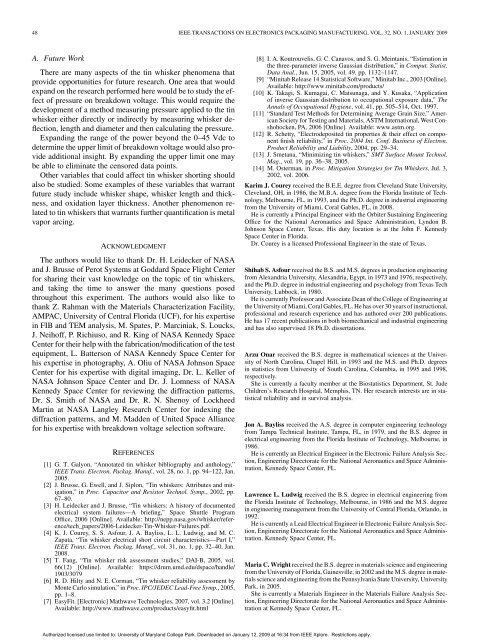
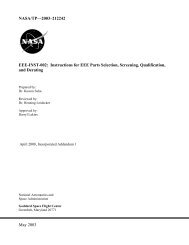

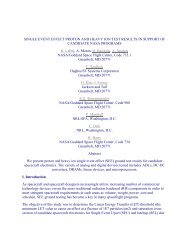
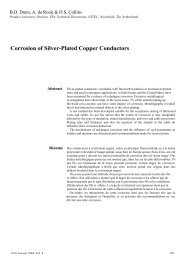
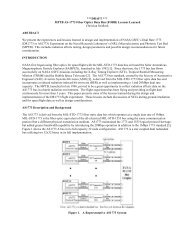

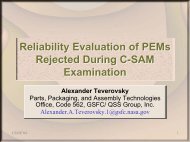
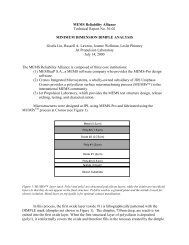
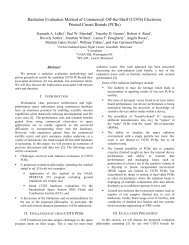
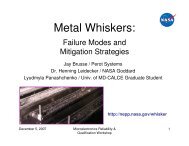
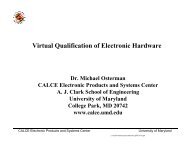
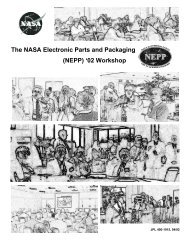
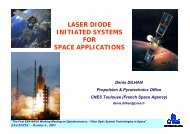
![mil-std-2223 [test methods for insulated electric wire] - NEPP](https://img.yumpu.com/4036001/1/190x249/mil-std-2223-test-methods-for-insulated-electric-wire-nepp.jpg?quality=85)